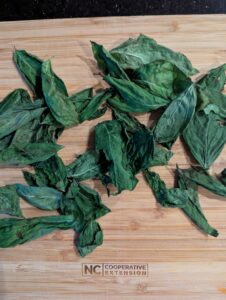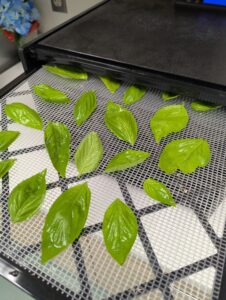Preserving Herbs
go.ncsu.edu/readext?1082605
en Español / em Português
El inglés es el idioma de control de esta página. En la medida en que haya algún conflicto entre la traducción al inglés y la traducción, el inglés prevalece.
Al hacer clic en el enlace de traducción se activa un servicio de traducción gratuito para convertir la página al español. Al igual que con cualquier traducción por Internet, la conversión no es sensible al contexto y puede que no traduzca el texto en su significado original. NC State Extension no garantiza la exactitud del texto traducido. Por favor, tenga en cuenta que algunas aplicaciones y/o servicios pueden no funcionar como se espera cuando se traducen.
Português
Inglês é o idioma de controle desta página. Na medida que haja algum conflito entre o texto original em Inglês e a tradução, o Inglês prevalece.
Ao clicar no link de tradução, um serviço gratuito de tradução será ativado para converter a página para o Português. Como em qualquer tradução pela internet, a conversão não é sensivel ao contexto e pode não ocorrer a tradução para o significado orginal. O serviço de Extensão da Carolina do Norte (NC State Extension) não garante a exatidão do texto traduzido. Por favor, observe que algumas funções ou serviços podem não funcionar como esperado após a tradução.
English
English is the controlling language of this page. To the extent there is any conflict between the English text and the translation, English controls.
Clicking on the translation link activates a free translation service to convert the page to Spanish. As with any Internet translation, the conversion is not context-sensitive and may not translate the text to its original meaning. NC State Extension does not guarantee the accuracy of the translated text. Please note that some applications and/or services may not function as expected when translated.
Collapse ▲In last week’s column I talked about harvesting basil at the N.C. Cooperative Extension office’s garden at the Government Center in Bolivia. We have a great crop that needed to be picked. We made and froze over 14 cups of pesto.
 But this led to the question, how else can we preserve this (and other) herbs to avoid
But this led to the question, how else can we preserve this (and other) herbs to avoid
wasting them. Herbs acquire their fragrance and flavor from oils that evaporate into the air when the leaves are crushed. However, once harvested, fresh herbs have a relatively short life. To preserve herbs for extended use, there are two basic methods: freezing and drying.
Drying is best done in a food dehydrator or in the microwave. Sun drying is not recommended because the herbs tend to lose flavor and color.
Some herbs can be simply air dried, but this requires low humidity (which obviously we don’t have!) Oven drying is also not recommended, because even the oven’s lowest temperature destroys much of the flavor, oils and color.
Dehydrator drying is a fast and easy way to preserve large amounts of herbs because
temperature and air circulation can be controlled. Set the dehydrator’s thermostat at
95°F to 115°F. When the humidity is high, you may need to go up to 125°F. After rinsing under cool, running water and shaking to remove excess moisture, place the herbs in a single layer on dehydrator trays. Place stems so they do not touch. Drying times may vary from 1-4 hours. Drying our basil leaves took over 3 hours in our dehydrator.
Microwave ovens are a way to dry herbs when you have only a small amount. Place a single layer of clean, dry leaves between dry paper towels or on a paper plate. Place them in the microwave for 30 seconds to 2 minutes on high power. Start with a small amount of time and then add more in small increments. Drying time will vary with the
moisture content of the herb, how many herbs you are drying and the wattage of the
microwave oven. Thicker leaves may need to stand and air dry before they become brittle. Stay in the kitchen and watch carefully to not burn the leaves or start a fire in the microwave. The basil we dried took about 45 seconds for 10 leaves—they were still slightly moist when we took them out of the microwave, so we allowed them to air dry for about an hour until they were brittle and easily crumbled.
 Dried herbs are usually 3 to 4 times stronger than the fresh herbs. To substitute dried herbs in a recipe that calls for fresh herbs, use 1/4 to 1/3 of the amount listed in the recipe. To preserve full flavor, avoid crushing the leaves until you are ready to use. Store dried herbs in glass or plastic containers or heavy-duty zip-top plastic bags in a cool, dry place away from sunlight, moisture, and heat. Many herbs can be kept for a year if stored properly.
Dried herbs are usually 3 to 4 times stronger than the fresh herbs. To substitute dried herbs in a recipe that calls for fresh herbs, use 1/4 to 1/3 of the amount listed in the recipe. To preserve full flavor, avoid crushing the leaves until you are ready to use. Store dried herbs in glass or plastic containers or heavy-duty zip-top plastic bags in a cool, dry place away from sunlight, moisture, and heat. Many herbs can be kept for a year if stored properly.
Freezing is also a quick and easy way to preserve herbs. Rinse the herbs quickly in cold water, shake off the excess, then chop coarsely. Place generous pinches of herbs in water-filled ice cube trays and freeze. Transfer herb-cubes to plastic bags or air tight plastic containers.
Another method for freezing is to spread the herbs loosely onto a cookie sheet and
freeze. Then transfer the frozen herbs into freezer containers or bags and seal. When
they thaw, herbs will not be suitable for garnishes, but can be used in cooking. Although frozen herbs may be safe to eat after a year or longer, it is recommended that they be used within 3–6 months for best quality. Do not re-freeze herbs after thawing.
If you’re interested in learning more about drying foods and using a dehydrator, we have a class coming up on September 25 at 2 p.m. at the Cooperative Extension in Brunswick County in Bolivia. This class is part of a series of Food Preservation classes that will be offered this fall by our Family and Consumer Science Extension Agent, Avery Ashley along with our Extension Master Food Volunteers. Contact Ashley at our office for details about these classes and how to register.
Helpful Resources:
Syracuse is a Family and Consumer Science team member and can be reached at N.C. Cooperative Extension, Brunswick County Center 910-253-2610 or by email at clsyracu@ncsu.edu



